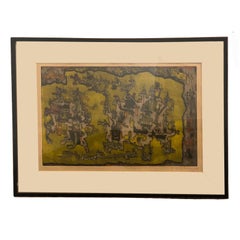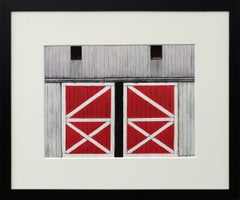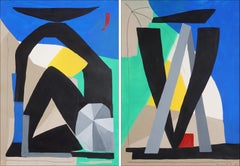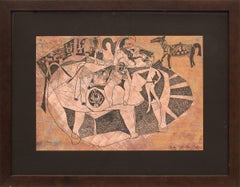Ynez Johnston Paintings
American, 1920-2019
Frances Ynez Johnston (May 12, 1920 – 2019) was an American painter, sculptor, printmaker and educator. Her artwork is modernist and abstract with a narrative of imaginative lands or creatures, and often featuring collage.
Johnston was born on May 12, 1920, in Berkeley, California. She attended University of California, Berkeley to study with Worth Ryder and received her bachelor of fine arts in 1941. She traveled to Mexico in the early 1940s to continue her studies, returning to Berkeley in 1943, earning her Masters of Fine Arts in 1946.
In 1960 she married novelist and poet John Berry. In the years following she produced prints through the Tamarind Lithography Workshop.
Johnston started teaching art classes at various universities and colleges in 1950 and ended teaching in 1980.[8] She began at University of California, Berkeley (1950–1951) and then continued her teaching career at Colorado Springs Fine Art Center (1954–1955), Chouinard Art Institute (1956), California State College (1966–1967, 1969, 1973), the University of Jerusalem (1967), and Otis Art Institute of Parsons School of Design (1978–1980).
Her work is featured in various permanent collections including the Museum of Modern Art (MoMA), the Whitney Museum of American Art, the Metropolitan Museum of Art, the Smithsonian American Art Museum, the Art Institute of Chicago, the Los Angeles County Museum of Art (LACMA), the Spencer Museum of Art, the National Gallery of Art, Fullerton College, the McNay Art Museum, the University of Michigan Museum of Art, the Indianapolis Museum of Art, and others.
Johnston was awarded a Guggenheim Fellowship in 1952 for fine art, which allowed her travel to Italy. In 1955–1956 she was awarded the Louis Comfort Tiffany Foundation grant for painting and printmaking, and was awarded the National Endowment for the Art (NEA) grant in 1976 and 1986.
In addition to her intricate prints and paintings, Johnston also created three dimensional pieces in collaboration with her husband and with ceramic sculptor Adam Mekler.
Her watercolors, oils and etchings of the 1950s and 1960s were rich with complex imagery, and displayed a disciplined, restrained use of color. In later mixed-media pieces, she examined the tactile qualities of surface. Her paintings incorporated soil, acrylic, dyes, encaustic on cloth, canvas, and raw silk. Composite forms suggest ambiguous architectural, human, animal and plant shapes. Johnston cited Persian and Indian miniatures as influences but also drew inspiration from European abstract artists Matisse, Miro, Klee and Picasso.
Ynez Johnston died in 2019 in Los Angeles, California.to
1
Overall Width
to
Overall Height
to
1
1
1
1
1
6
780
719
711
686
1
1
Artist: Ynez Johnston
"HUNTING SCENE II" Lithograph by Ynez Johnston
By Ynez Johnston
Located in Pasadena, CA
"Hunting Scene II," a lithograph by American artist Ynez Johnston created in 1964, is part of a series published by the International Graphic Arts Society (IGAS) in September 1965. L...
Category
1960s Modern Ynez Johnston Paintings
Materials
Paper
Related Items
George Vander Sluis Mid-Century Modern Barn Landscape Oil Stick on Paper
Located in Denver, CO
This original mid-20th-century oil stick on paper by acclaimed American modernist George Vander Sluis (1915–1984), titled Barn Side with Sliding Do...
Category
1980s American Modern Ynez Johnston Paintings
Materials
Paper, Oil Pastel
$1,570
H 23 in W 27 in D 0.75 in
Abstract Cubist Diptych of Human Figures, Sitting with Each Other, Black, Blue
Located in Barcelona, ES
This is a beautiful painting by Alberto de Blobs (Barcleona, 1982). Alberto is a talented painter whose elaborate mixture of figurative and free form ...
Category
2010s Modern Ynez Johnston Paintings
Materials
Acrylic, Paper
Alberto de BlobsAbstract Cubist Diptych of Human Figures, Sitting with Each Other, Black, Blue, 2024
$1,050
H 28 in W 40 in D 0.1 in
Thom O'Connor Pastel on Paper "The Model #5"
By Thom O'Connor
Located in Detroit, MI
"The Model #5" is a pastel on paper showing a nude female figure emerging from what appears to be an evening darkening mist where a distant landscape is suggested or perhaps she is e...
Category
Late 20th Century American Modern Ynez Johnston Paintings
Materials
Pastel, Paper
Untitled, Woodcut on Paper, Figurative by Haren Das "In Stock"
By Haren Das
Located in Kolkata, West Bengal
Haren Das - Untitled
Woodcut on Paper
12.28 x 9 inches, 1991
( Unframed & Delivered )
This 1991 print by Haren Das beautifully captures a serene rural scene with fine detailing and ...
Category
1990s Modern Ynez Johnston Paintings
Materials
Paper, Woodcut
$2,600
H 9 in W 12.28 in D 1 in
1940's American WPA Modernist New York City Watercolor Painting Tenement Market
By Samuel Grunvald
Located in Surfside, FL
The Market, (fauvist painting of NYC scene) 1940's.
image is 10X 11.5 inches. Hand signed lower right
Lower East Side Tenements Pushcart Market
Watercolor on paper board.
Samuel G...
Category
1940s Modern Ynez Johnston Paintings
Materials
Watercolor, Board, Paper
Valentino Fall Oil Pastel on Paper. Fashion painting on paper
By Manuel Santelices
Located in Miami Beach, FL
The artist has covered New York collections for over 16 years and has interviewed, as a journalist, several fashion designers and personalities for different publications. He loves t...
Category
2010s Modern Ynez Johnston Paintings
Materials
Paper, Oil Pastel
$600
H 12 in W 9 in D 0.1 in
Untitled, Mixed Media on Paper by Indian Modern Artist Sunil Das "In Stock"
By Sunil Das
Located in Kolkata, West Bengal
Sunil Das - Untitled
Mixed Media on Paper
14 x 12 inches, 1988
( Unframed & Delivered )
This striking work by Sunil Das (1988), rendered in mixed media on paper, reflects the artist...
Category
1980s Modern Ynez Johnston Paintings
Materials
Paper, Mixed Media
$1,465
H 14 in W 12 in D 1 in
“Six Figures, c. 1965-70” by Sakti Burman (b. 1935) Indian Folklore Watercolor
By Sakti Burman
Located in Yardley, PA
“Six Figures, c. 1965-70” by Sakti Burman (b. 1935).
A wonderful example of Burman’s distinctive fusion of Indian folkloric imagery with European surrealist and fantastical sensibil...
Category
1960s Modern Ynez Johnston Paintings
Materials
Paper, Ink, Watercolor
$6,950
H 31.5 in W 37.5 in D 1.5 in
“Untitled”
By Nahum Tschacbasov
Located in Southampton, NY
Unframed
Signed and dated lower left 1946
Category
1940s Modern Ynez Johnston Paintings
Materials
Paper, Ink
Gordon Barker, It's Snowing, Original Landscape Painting, Winter Art, Bright Art
Located in Deddington, GB
It’s Snowing by Gordon Barker [2016]
original
Acrylic on paper
Image size: H:25.5 cm x W:35 cm
Complete Size of Unframed Work: H:25.5 cm x W:35 cm x D:0...
Category
2010s Modern Ynez Johnston Paintings
Materials
Paper, Acrylic
Gordon Barker Gordon Barker, It's Snowing, Original Landscape Painting, Winter Art, Bright Art, 2022
$240
H 10.04 in W 13.78 in D 0.04 in
Untitled, Figurative, Dry Pastel on Paper by Jogen Chowdhury "In Stock"
By Jogen Chowdhury
Located in Kolkata, West Bengal
Jogen Chowdhury
Untitled
Dry Pastel on Paper
11.6 x 8.3 inches, 2023
( Framed & Delivered )
Modern Indian artist Jogen Chowdhury executed Still life drawing in Ink, pastel.
Always...
Category
2010s Modern Ynez Johnston Paintings
Materials
Paper, Pastel, Mixed Media
$3,840
H 11.6 in W 8.3 in D 1 in
Brutalist Columns, Abstract Black and White, Cryptic Text, Oil Crayon on Paper
Located in Barcelona, ES
This is a beautiful painting by Alberto de Blobs (Barcleona, 1982). Alberto is a talented painter whose elaborate mixture of figurative and free form ...
Category
2010s Modern Ynez Johnston Paintings
Materials
Watercolor, Oil Crayon, Paper
Alberto de BlobsBrutalist Columns, Abstract Black and White, Cryptic Text, Oil Crayon on Paper, 2024
$890
H 40 in W 28 in D 0.1 in
Previously Available Items
Untitled
By Ynez Johnston
Located in Denver, CO
Mixed media on paper. Presented in a custom frame, outer dimensions measure 21 ¼ x 26 ¾ x ¾ inches. Image size is 13 ¼ x 19 ¼ inches.
A native of Berkeley, Johnston's artistic talent received encouragement from her family who enrolled her in Saturday classes at the California College of Arts in Oakland with excursions to the de Young Memorial Museum in San Francisco. In 1941 she received her Bachelor of Fine Arts degree from the University of California at Berkeley and the Bertha B. Taussig Memorial Award for the outstanding graduate in fine arts. Her instructors Worth Ryder, Erle Lorain and Margaret...
Category
Mid-20th Century American Modern Ynez Johnston Paintings
Materials
Mixed Media
Ynez Johnston paintings for sale on 1stDibs.
Find a wide variety of authentic Ynez Johnston paintings available for sale on 1stDibs. You can also browse by medium to find art by Ynez Johnston in mixed media, paint, paper and more. Much of the original work by this artist or collective was created during the 1950s and is mostly associated with the abstract style. Not every interior allows for large Ynez Johnston paintings, so small editions measuring 18 inches across are available. Customers who are interested in this artist might also find the work of Rex Ashlock, Fred Mitchell, and Charles Ragland Bunnell. Ynez Johnston paintings prices can differ depending upon medium, time period and other attributes. On 1stDibs, the price for these items starts at $9,500 and tops out at $9,500, while the average work can sell for $9,500.



